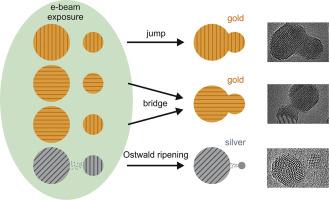Mechanisms of Au and Ag nanoparticle array evolution studied by in-situ TEM and molecular dynamics simulation
IF 8.3
2区 材料科学
Q1 MATERIALS SCIENCE, MULTIDISCIPLINARY
引用次数: 0
Abstract
Understanding the formation and evolution of arrays of metallic nanoparticles is a very important task as they are increasingly used in various devices. In this work, we used HRTEM mode for continuous in-situ observations of the evolution of Ag and Au nanoparticle arrays with an average size of ∼4 nm, formed on the surface of amorphous carbon by vacuum-thermal evaporation, under the influence of a microscope electron beam without any other energetic influence. Our studies show that electron beam exposure induces a process of nanoparticle coalescence for Au and simultaneous coalescence and vaporization for Ag. As a result, the evolution of Ag and Au nanoparticle arrays has different mechanisms. In the case of Ag, the aggregation of nanoparticles occurs through the gas phase by the Ostwald ripening mechanism. In the case of Au, it was found that the aggregation of nanoparticles depends on their mutual crystalline orientation, resulting in the realization of mechanisms through bridge formation or through jumping. The influence of the crystalline orientation of the nanoparticles on the coalescence mechanism was confirmed by molecular dynamics simulations. MD simulations revealed that it is most favorable for coalescence if the densely packed planes of neighboring nanoparticles have a perpendicular arrangement in space.

通过原位 TEM 和分子动力学模拟研究金纳米粒子和银纳米粒子阵列演化的机理
随着金属纳米粒子在各种设备中的应用日益广泛,了解金属纳米粒子阵列的形成和演变是一项非常重要的任务。在这项工作中,我们使用 HRTEM 模式对无定形碳表面通过真空-热蒸发形成的平均尺寸为 4 纳米的银和金纳米粒子阵列的演化过程进行了连续的原位观测,观测过程受到显微镜电子束的影响,而没有受到任何其他能量的影响。我们的研究表明,电子束照射诱导了金纳米粒子的凝聚过程,同时也诱导了银纳米粒子的凝聚和气化过程。因此,金银纳米粒子阵列的演化具有不同的机制。对于银,纳米粒子的聚集是通过气相的奥斯特瓦尔德熟化机制发生的。在金的情况下,研究发现纳米粒子的聚集取决于它们的相互晶体取向,从而导致通过桥形成或通过跳跃实现机制。分子动力学模拟证实了纳米粒子的晶体取向对凝聚机制的影响。分子动力学模拟显示,如果相邻纳米粒子的密集平面在空间中呈垂直排列,则最有利于凝聚。
本文章由计算机程序翻译,如有差异,请以英文原文为准。
求助全文
约1分钟内获得全文
求助全文
来源期刊

ACS Applied Materials & Interfaces
工程技术-材料科学:综合
CiteScore
16.00
自引率
6.30%
发文量
4978
审稿时长
1.8 months
期刊介绍:
ACS Applied Materials & Interfaces is a leading interdisciplinary journal that brings together chemists, engineers, physicists, and biologists to explore the development and utilization of newly-discovered materials and interfacial processes for specific applications. Our journal has experienced remarkable growth since its establishment in 2009, both in terms of the number of articles published and the impact of the research showcased. We are proud to foster a truly global community, with the majority of published articles originating from outside the United States, reflecting the rapid growth of applied research worldwide.
 求助内容:
求助内容: 应助结果提醒方式:
应助结果提醒方式:


